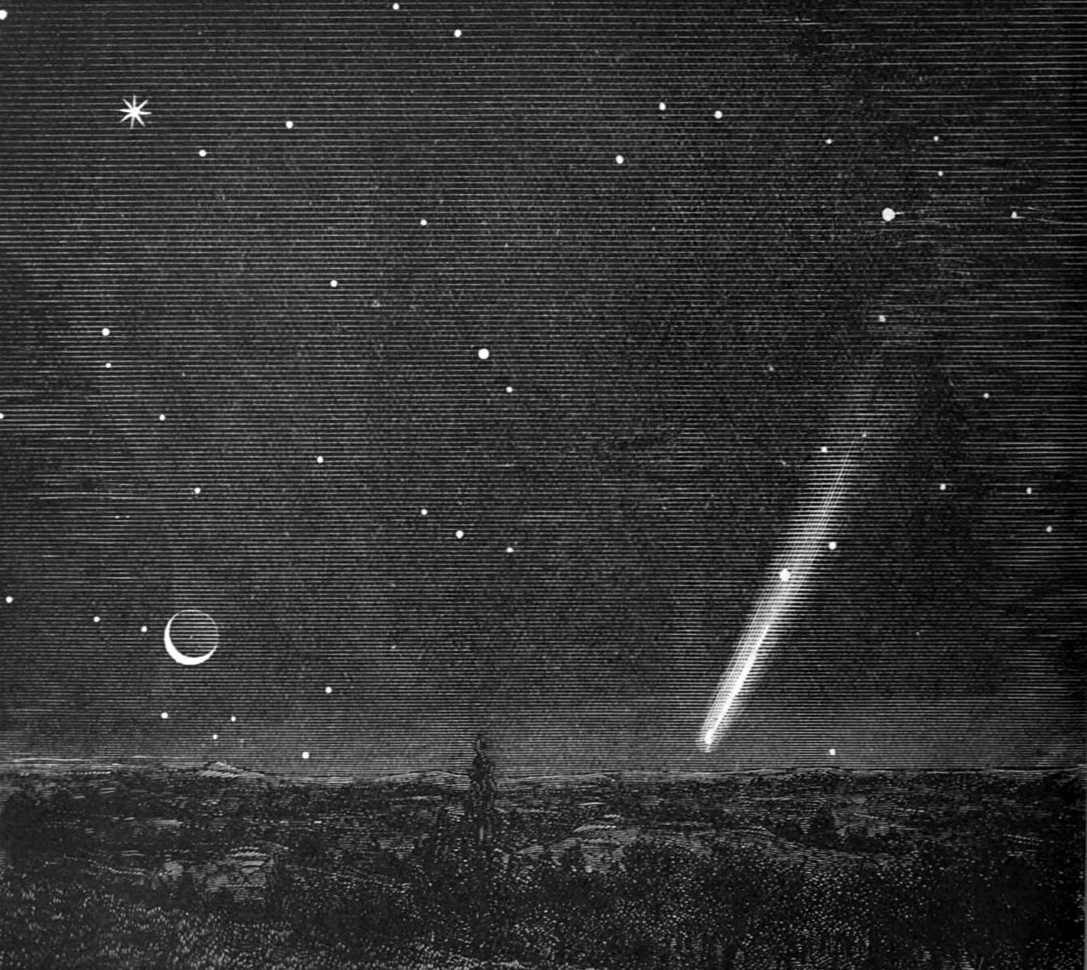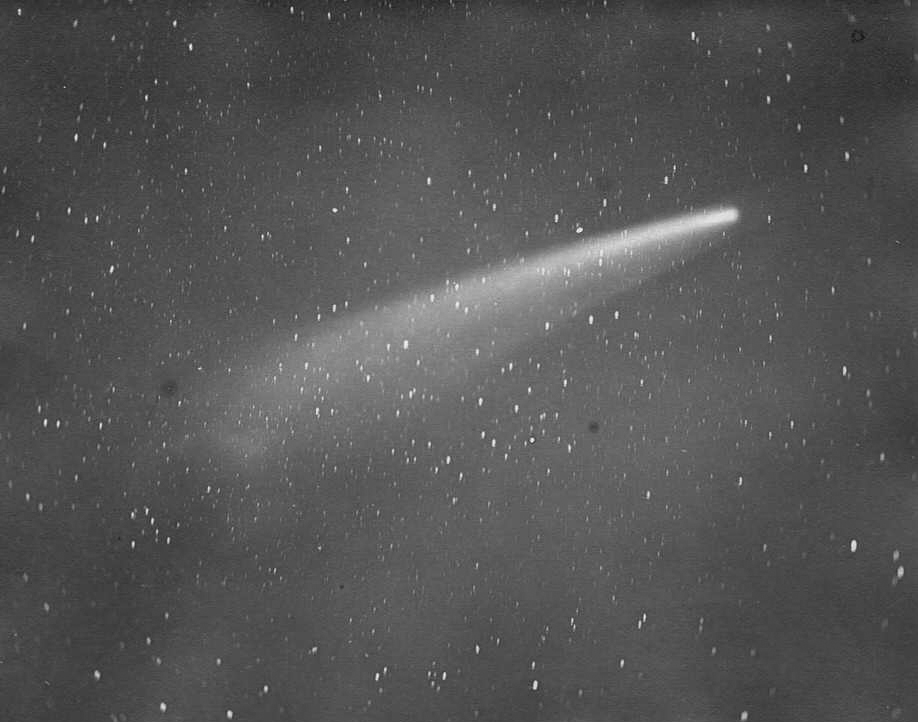
Perihelion: 1882 September 17.72, q = 0.008 AU
What can arguably be considered as one of the brightest and most spectacular comets of the entire 2nd Millennium was a Kreutz sungrazer, one of the most pre-eminent representatives of that class of objects that is the subject of a future “Special Topics” presentation. It was first sighted, not by astronomers, but by casual observers of the sky, including sailors aboard ship, during the first week of September 1882, with the earliest reported sightings being made on September 1 from the Cape of Good Hope and from the Gulf of Guinea. It was already a relatively conspicuous naked-eye object and numerous people spotted it over the next few days, with apparently the first astronomer to see it being William Finlay at the Cape Observatory in South Africa who independently discovered it on September 8 as he was returning home following a night’s observing at the Observatory; according to his report, it was already 3rd magnitude or brighter.
The comet was at an elongation of 30 degrees in the morning sky when first sighted, and it brightened rapidly as it approached the sun. Instead of disappearing into the dawn sky, however, its great brilliance allowed it to be kept under observation; on the 15th, when only 11 degrees from the sun, it was reported as being as bright as magnitude -2.
Shortly thereafter astronomers around the world began observing the comet in broad daylight. On the day of perihelion, September 17 – at which time the comet was between the sun and Earth and thus appeared at a high phase angle – it was so bright that all one had to do was cover the sun with an outstretched hand and it would be immediately visible. In South Africa, even while using a neutral density filter Finlay was telescopically able to follow the comet right up to the limb of the sun, suggesting a brightness as high as magnitude -14 and possibly as high as magnitude -17.
After perihelion, the comet moved back over into the morning sky, although it remained visible to the unaided eye during daytime for another day or two and telescopically until the 25th. It rapidly grew a tail that was up to 25 degrees long, and that was so bright that, according to one observer, the comet and ten degrees of its tail remained visible in the dawn even after 1st-magnitude stars had already disappeared. Although it faded as it receded from the sun it did so rather slowly, being between magnitude 1 and 0 at the beginning of October and 2nd magnitude throughout the latter half of that month.

During the early days of October, several astronomers began reporting individual nuclear fragments within the inner coma, and eventually, as many as six of these were reported, all strung out along the comet-sun line. A rather bizarre phenomenon – somewhat unique in the history of comet observations – began to appear around the beginning of the second week of October, when several astronomers started seeing apparent “satellite” telescopic comets to the southwest of the main comet. On the morning of October 14, the American astronomer Edward Barnard reported seeing as many as six to eight of these, and possibly as many as ten to fifteen – at least one of these being as large as 15 arcminutes across – all within about six degrees of the main comet. While these were apparently short-lived phenomena, Barnard and other observers also reported that the entire comet, together with these “satellite” objects, appeared to be encompassed within a large tail-shaped “sheath” which extended well in front of the comet and appeared to produce what we now call an “anti-tail.” This entire structure disappeared by about the end of October, and it is not entirely clear just what produced it; some speculations suggest it may be due to dust released during the comet’s previous perihelion passage several centuries earlier.
Most Kreutz sungrazers tend to fade away very quickly, but the Great Comet of 1882 proved to be an exception to this. It was still 3rd magnitude in December, and even when near opposition in January 1883 was still as bright as 4th magnitude with a tail 10 to 15 degrees long. It remained visible to the unaided eye until February, at which time its heliocentric distance was 3 AU, and thereafter was followed telescopically until the beginning of June, by which time its heliocentric distance had increased to 4.4 AU and it was disappearing into evening twilight.
The Great Comet of 1882 was one of several comets in the early to mid-1880s that traveled on very similar orbits, as also did the Great Comet of 1843 (a previous “Comet of the Week”). The German astronomer Heinrich Kreutz studied the various comets and concluded that they were all likely fragments of an earlier comet that had split up on a previous return, noting that the splitting of the 1882 comet provided evidence for the continuation of this process. Numerous other comets with the same basic orbit have appeared since then, and the overall story of these “Kreutz sungrazers” is the subject of a future “Special Topics” presentation. As for the various fragments of the Great Comet of 1882, at least four seem to have survived and were well enough observed to have separate orbits computed for them; their approximate orbital periods range from 670 to 950 years.
Although Comet Donati 1858 VI – next week’s “Comet of the Week” – was the first comet to be photographed, it was a 100-minute exposure of the Great Comet of 1882 taken on November 7 of that year by the Director of the Cape Observatory in South Africa, David Gill, that provided a paradigm shift in the usage of astrophotography. Gill’s photograph showed so many stars that many astronomers began to realize the value of photography for celestial mapping and astronomical research in general, and this stimulated the holding of the first major international astronomical conference, which was held in Paris in April 1887 and which delegates from almost 20 countries attended. From this conference sprang the first major international collaborative astronomical project, the making of an all-sky photographic map of the sky dubbed the Carte du Ciel. Although this effort was later superseded by more efficient methods, it nevertheless ranks among the more important legacies of this most spectacular of comets.
More from Week 40:
This Week in History Special Topic Free PDF Download Glossary
Ice and Stone 2020 Home Page


